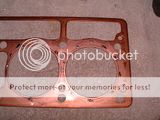actually the motor is from an early 4A. I have a couple motors to choose from for my 59 TR3A project, but the 4A engine turns easily and is complete. I've never done a wet liner engine before. I've built a couple of TR6 engines and a couple of small block Chevy motors over the years, and mostly, they held together. I've dismantled the engine, and am in the process of ordering some parts. The main pins looks like it is .20 thou under, and the crank pins are 10 thou under. I'm going to take the crank to a machine shop and see how out of round it might be before I order bearings. One of the con rods is obviously slightly bent. The corresponding cam lobe is a bit pitted, although the lifter looks fine. I've got another set of straight con rods I can use. Otherwise, I think I have a good pIatform from which to start, I've read a lot about these engines, and I'm confident I can build a good reliable engine. I'll have lots of questions from those of you who are willing to offer advice. The car is just for fun. I have no aspirations to do anything with it other than play with it. I know I need all the major internals including a new piston/liner set and cam. My question for the day is: If money is no object (of course it is) Is there any reason NOT to go with 89 mm pistons? Rimmer brothers has an AE 89mm set for basically the same price as the 87mm county brand that TRF sells, and only slightly more than the other brand 87mm piston/liner that BPNW and Moss sells. I figure the more displacement, the better I plan on increasing the compression only slightly, and using a 270 degree cam. I have a header, and I will do some porting on the head. Any advice about the 89mm AE piston/liners would be appreciated. I see that most of the vendors sell a head gasket to use with the larger displacement set. Are there any other problems?
Joe
Joe

 Hi Guest!
Hi Guest!

 smilie in place of the real @
smilie in place of the real @
 Pretty Please - add it to our Events forum(s) and add to the calendar! >>
Pretty Please - add it to our Events forum(s) and add to the calendar! >> 

